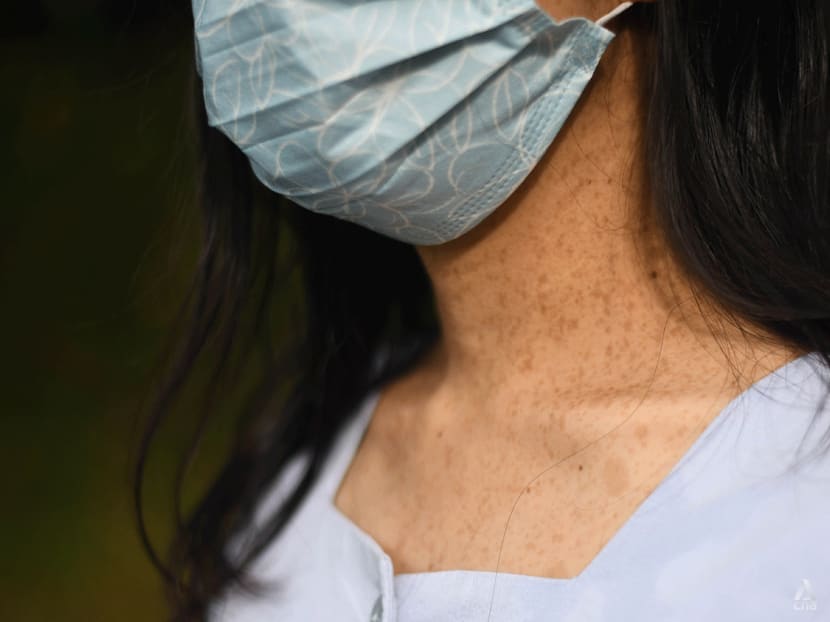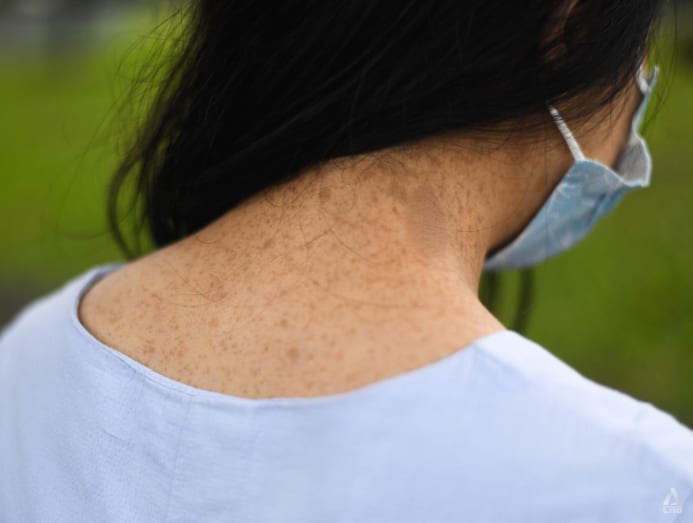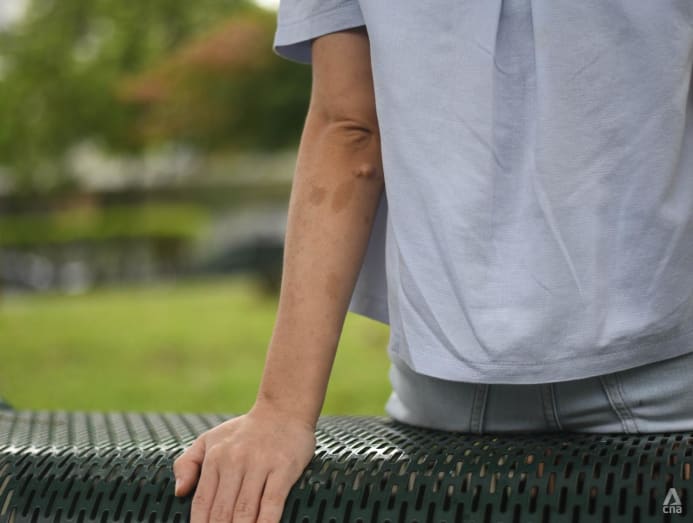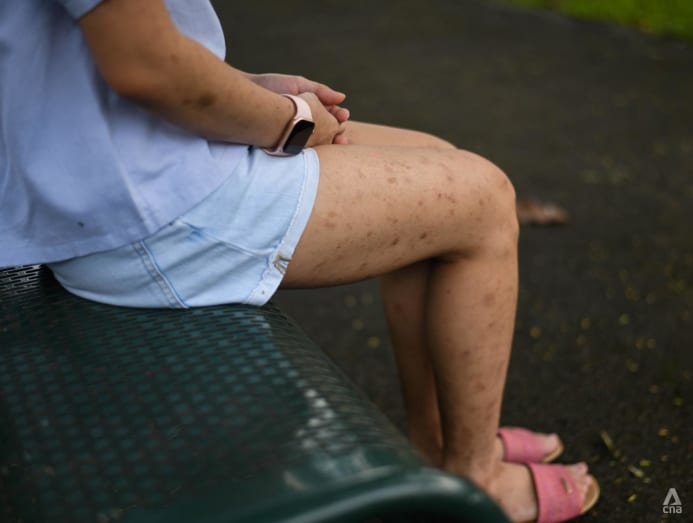What it’s like for this 27-year-old to live with brown spots and growths all over her body
Christa Tan has had these spots and growths since birth, a result of a genetic condition called neurofibromatosis 1 or NF1, a commonly undiagnosed condition that could turn cancerous. She talks about what it’s like to live with the disease. As told to CNA Women’s Sharon Salim.

Since birth, Christa Tan has had pigmentation that appears all over her body. She was officially diagnosed with a genetic condition called neurofibromatosis 1 (or NF1) in February this year. (Photo: Kelly Hui/CNA)
I grew up with brown spots and skin lesions all over my body. When I was younger, the doctors said the brown spots, which were the size of 20- and 50-cent coins, would go away over time. But they didn’t. Instead, they became more pronounced at areas such as my stomach, chest and back, as compared to my face, hands and legs.
They weren’t painful and I didn’t think that it could be serious, although it made me feel very self-conscious in primary school. When I went swimming, I would make sure to wear a T-shirt and shorts over my swimsuit.

Then, in primary five, I heard my doctors mention a condition called neurofibromatosis 1, also known as NF1 – and it hit me that the brown spots could be linked to a medical condition.
Neurofibromatosis is a genetic condition that manifests as skin pigmentation in the form of light brown spots, and nerve tumours that can grow on or under the skin.
While I was aware that my condition could be NF1, it had never been officially diagnosed.
In Secondary 3, I became even more self-conscious about the brown spots and skin lesions. It was very hard to explain to people what they were – I just wanted to hide in my own bubble.
BEING SELF-CONSCIOUS ABOUT HER APPEARANCE
As women, we are always self-conscious about our appearance, and the pigmentation and skin lesions make me more so. Going to the beach is beyond my comfort zone – I can never picture myself in a swimming costume. I still need the security of my “comfort clothing”, which are typically T-shirt and shorts, and I avoid going swimming.
I would also avoid wearing revealing clothes and make sure that I wear enough to cover the areas I feel more self-conscious about.
WHAT TO KNOW ABOUT NEUROFIBROMATOSIS 1 (NF1)
What it is: NF1 is part of a group of genetic conditions called neurofibromatosis, said Associate Professor Joanne Ngeow, Senior Consultant at the Division of Medical Oncology, and the head of Cancer Genetics Service at the National Cancer Centre Singapore (NCCS).
As a whole, NF is a highly under-diagnosed condition in Singapore, said Assoc Prof Ngeow. Aside from NF1, the most common form, there are two other types of NF – NF2 and schwannomatosis.
Risk factors: Assoc Prof Ngeow said that about half of all NF cases inherit the condition from their parents, while the other half is a result of a spontaneous mutation of the NF1 or NF2 genes during conception. All individuals who have NF have a 50 per cent chance of passing it onto their children. It does not skip generations, and can affect both males and females from all ethnicities.
People with NF1 also have an increased risk of cancers, such as breast cancer and brain cancer.
Incidence rates in Singapore: NCCS’ Cancer Genetics Service currently manages about 30 families with NF1. “We expect the incidence rate of NF1 individuals to be 1:3000 in our local population, similar to that of other populations globally,” said Assoc Prof Ngeow.
Symptoms: Only a physician can make a formal diagnosis of NF1, and the patient must meet two or more of the following criteria:
- A family member with NF1.
- Six or more cafe-au-lait macules, which are skin pigmentation in the form of multiple flat, light brown spots on the skin.
- Freckling in the armpit or groin.
- Two or more neurofibroma tumours (benign nerve tumours that can grow on or under the skin) or one plexiform neurofibroma (a larger and deeper tumour around the nerves). “10 per cent of plexiform neurofibromas may become cancerous,” Assoc Prof Ngeow said.
- Optic pathway glioma, which is a tumour that grows along the optic nerve in the brain.
- Osseous lesion, a bony lesion, such as sphenoid dysplasia, an abnormal growth of the bone behind the eye.
- A faulty NF1 gene found by genetic testing.
“The severity of symptoms can range from extremely mild to severe, and can vary within individuals of the same family as well. There is no way to predict who will have a mild case or who will develop more serious symptoms, but the majority of individuals (60 per cent) usually experience minor symptoms,” said Assoc Prof Ngeow.
Screening, management and treatment: There is no cure for NF, she said, but the symptoms can be managed; and the sooner it’s done, the better the outcome.
“As NF1 can affect different parts of the body… doctors and healthcare professionals from different specialties may be involved in the care of NF1 patients, which may include dermatologists, neurologists, ophthalmologists, orthopaedists, oncologists, cardiologists and genetic counsellors,” said Assoc Prof Ngeow.
She added that anyone who has features suggestive of NF should consider further assessment with a genetics service. You can ask your primary doctor for a referral for genetic counselling, to confirm the presence of a genetic condition within the family, if any. It usually involves a one-time blood test.
Depending on the symptoms and signs associated with NF1, screening and treatment include annual physical and eye examinations, the option of surgically removing benign nerve tumours and surveillance for children with a type of skin lesion called xanthogranulomas.
WORRYING ABOUT CANCER
Within the last two to three years, I’ve begun to notice lumps on my arms, back and chest, which worry me.
Then, in late 2021, I developed severe aches in my shoulders and neck. The pain got so bad that I had difficulty lifting my left arm, which is my dominant arm. I went to the Accident & Emergency Department, where doctors found that an artery in my neck was inflamed and compressing on a nerve.

The neurologist told me that the nerve was too near the spinal cord – so surgery (to relieve the pressure in the artery) was not suitable. I was prescribed medication to manage the pain and bring down the inflammation of the artery, and had to undergo physiotherapy to rebuild my muscle. Thanks to the medication and physiotherapy, the pain went away after a few weeks, and my left arm went back to normal.
However, the neurologist suspected that the inflamed artery could be due to NF1 and advised me to go for genetic testing at NCCS. Until then, while I was aware that my condition could be NF1, it had never been officially diagnosed.
NF is a highly under-diagnosed condition in Singapore.
I went for genetic testing in February this year, hoping to understand the underlying cause of the different conditions I’ve had since young, including dyslexia and a rare vascular disorder which reduces blood flow to the brain.
The genetic test confirmed that I have NF1, just as what my parents and I have long suspected.

The genetic counsellor explained that because it’s a genetic condition, there’s a 50-50 chance of my passing on the NF1 gene to my future children. My parents don’t have the condition, so my NF1 was caused by a spontaneous gene mutation during conception.
She also explained the possibility of more medical problems. As NF1 can cause tumours to grow on the nerves in the spinal cord, brain or other parts of the body, these growths can sometimes become cancerous – so those with NF1 have an increased risk of cancer, including breast and brain cancer.
FINDING ACCEPTANCE AND LIVING BRAVELY
I am 27 years old and currently single. I have no plans for marriage yet, although I’d be lying if I say that I don’t worry about my brown spots – there are certain times in a relationship where I feel self-conscious about them.

In my past relationships, I have never been shamed for the brown spots, and I know that the right partner will not shame me for it. I live a pretty normal life, even with NF1. I work as a digital marketing specialist, and I enjoy activities with my friends and family.
I have many things to be thankful for, including my family, who has always been supportive. My parents and siblings have never made me feel different, and because of that, I have felt very loved. Having that psychological and emotional support has been very helpful.
I’d be lying if I say that I don’t worry about my brown spots – there are certain times in a relationship where I feel self-conscious about them.
After the diagnosis, I feel more empowered as I now know what to expect, and can better manage the symptoms and what to look out for.
My own acceptance of NF1 has allowed me to feel more comfortable about it – it’s believing that you are more than just your appearance. You don’t want the world to only like you for the way you look.

The doctors told me that while most patients with NF1 will have normal lives, it’s important to look out for growths, such as when they start to pop up, or when they get bigger or abnormally large. These abnormalities are signs to look out for that may point to cancer.
And since the compressed nerve incident, I’ve also had to avoid strenuous activities and not carry heavy items to avoid triggering the artery.
The thing about having NF1 is you don’t really know what’s going to happen – the severity of symptoms can range from extremely mild to severe, and there is no way to predict who will have a mild case or who will develop more serious symptoms.
Over the years, I’ve learnt to be more gentle with myself. There’s little I can control – growing up with many medical conditions helped me find freedom and joy in life, as I learnt to take things as they come, and trust that all will be well.
CNA Women is a section on CNA Lifestyle that seeks to inform, empower and inspire the modern woman. If you have women-related news, issues and ideas to share with us, email CNAWomen [at] mediacorp.com.sg.








